We headed towards Bordeaux to spend the night. As we were came to Bordeaux, we drove around a roundabout with statues of pilgrims walking the pilgrimage road, Santiago de Compostela, one of the beginner routes that goes through Bordeaux into Spain.
Bordeaux was first settled by Celtics and later came under Roman rule but today is a thriving student town. We took an orientation walk through Bordeaux the next morning. As we walked around, it reminded me of Paris, a very modern town with many museums, galleries and trendy shops. We went to the Cathedrale St Andre and then passed by a museum, wine schools, then headed to the Esplanade des Quinconces, a huge square with the Girondins monument fountain.
The Girondins were moderate National Assembly deputies during the French revolution, some of whom were executed in 1793 for counter revolutionary activities. I would have liked to explore more of this town and try out its cuisine and wine but time did not permit this.
We drove through Dordogne, one of France’s most scenic areas, with castles, vineyards and picturesque villages. It’s also well-known for it’s highly prized black truffle, referred to as the Black Diamond, a black mushroom that grows in chalky areas around roots of oak trees. We stopped at Sarlat-la-Caneda, in Perigord Noir (Black Perigord) a charming town of honey colored 15th and 16th century stone buildings and boutiques near the Dordogne River.
The Rue de la Republique runs the length of the old town, with mazes of narrow streets on either side. I wandered around its medieval cobbled streets immersing in its gorgeous medieval architecture and discovering pretty “hidden” alleyways and twisted back streets. Every corner I turned to was beautiful! Colorful flowers and amazing architectural designs of doors and windows meet us at every corner and alleyway. I walked by pretty cafes and stalls selling foie gras, walnuts, wine and cheeses. I went slightly uphill and found the coziest garden style café…in the inner courtyard of the cafe. I just fell in love with this place!
I sat and took my time, drinking the local rose wine and chatting to a lady at the next table, a tourist from England. I ordered chicken with mushroom truffle sauce (possibly shavings of truffle as truffle is rather expensive).
I was in heaven! And the waiter was friendly and the weather was great!
Sadly I had to leave after lunch and walked towards the geese market square where a bronze statue of three life-sized geese stands, reminding us of Sarlat’s special gastronomic specialty, the foie gras.
I walked by many stores selling all kinds of goose based specialties, truffles and olive oil. I bought a few items to make a local meal in my kitchen when I return. Then I walked towards the exit passing by Cathedrale St Sacerdos, which has a great mix of architectural style.
As we drove through Dordogne country to the north of Cahor, we passed by hilltops studded with castles, and green meadows stretched along the meandering riverbanks.
Finally we arrived at the fortified medieval town, the pilgrimage town of Rocamadour, perched high upon the side of a cliff. Again what an amazing sight! As the bus was winding towards it from afar it was a magical site with steeples and stone facades of the chateau built on the side of a vertical cliff.
Pilgrims from all over the world come here to pay homage to the Black Madonna (Vierge Noir). The chateau on top was closed so we took the lift to the Sanctuaries (12th to 14thcentury chapels). I walked around and went into the Chapelle Notre Dame, which housed the Black Madonna. Then I climbed the steps down to the old city, which has many souvenir shops and cafes and restaurants. People here were so friendly and pleasant, unlike some of the close minded locals at Mont St. Michel!
The next stop was the fortified village of Carcassone, in the Languedoc region of Southern France and it was a beautiful drive there. It is perched on a rocky hilltop and built on a former Roman fortress. And it looks like a fairy tale castle from afar with its witch like roofs, ramparts walls and many stone towers.
As we walked over its drawbridge, I was a bit disappointed with the inside as it was not visually appealing and not as well preserved or restored as the other towns I had been so far.
I walked around and checked out some of its shops that had a great colorful display of cookies and sweets. I bought some local cookies and then we headed off towards the east to Nimes, an unimpressive town but which has a magnificent amphitheatre, and a 2000 year old preserved temple, the Maison Caree.
The twin tiered amphitheater, built around 100 AD, and where gladiator contests and executions were held, still stages bullfights and gladiator battles till today. We walked around and sat inside the arena listening to an audio guide telling its history.
Then driving northeast of Nimes, we came to Pont du Gard, another place with Roman sites. It is well known for its three-tiered aqueduct, once part of a 50 km long system of water channels that was built in 19 BC by Romans, to transport water from a spring in Uzes to Nimes.
As we walked towards the aqueduct bridge, I saw that it was immense! It reminded me of the Roman aqueduct at Segovia, Spain, the first and only aqueduct that I had seen. Then we walked on the bridge and took in some wonderful views. As I stood and looked out at the beautiful view, I kept thinking of the workers carrying these huge blocks of stone from nearby quarries to build this aqueduct bridge!
We continued our journey to Avignon, in Provence country which I have heard so much about! Avignon is an old city of art and culture and has been the seat of papal power since over 70 years dating back to the 14th century.
We went to the Palais de Papes (Pope Palace), which was built in 1309 when the Pope Clement V left Rome to settle in Avignon.
Then we walked by the Cathedrale Notre Dame des Doms, admiring its Romanesque architecture and where a golden statute of the Virgin Mary stands on top with outstretched arms, ‘protecting the city’.
I walked around exploring the city and taking in the bright colors of display kitchen towels, placemats, aprons and tablecloths, with olives, lavender and poppy designs, at stores and outdoor stalls, and could not resist buying some beautiful souvenirs of Provence.
Then I found a café along the street to have a delicious dinner of grilled fish with tapenade sauce (pureed or finely chopped black olives, capers and anchovies with olive oil and garlic) and local white wine. My first Provencal meal, and so far the best meal I have had! I wish I had more time to explore this artsy city.
The next morning we drove south to Arles, town of Vincent Van Gogh, the world renowned impressionist painter from France…and one of my favorites! He came from Holland to Paris and went to Arles to paint its bright colors. I walked towards The Cafe Terrace on the Place du Forum, which Van Gogh painted in oil, to have some tea and dessert. However, it was not open since the staff were just cleaning and preparing it for lunch. I was rather excited to be here and took a number of photos inside (they were kind to allow me in to take photos) and outside. Arles’s bright colors and lighting were an inspiration for Van Gogh and I could see why. Van Gogh produced over 300 paintings and drawings during his time in Arles. As I passed by a side street at Place du Forum to a shoe store, a favorite song of mine was playing. It was the Gipsy Kings! I walked in the store and enjoyed the music while checking their shoes…and did buy a pair of sandals. The store manager told me the Gipsy King musicians are from Arles (they perform in Spanish with an Andalusian accent). Although they were born in France, their parents were mostly gitanos, Spanish Romani people who fled Catalonia during the 1930s Spanish Civil War.
The Romans took Arles in 123 BC and expanded it into an important city and further, with Julius Ceasar’s victory, it became a prominent city. Arles has a well-preserved Roman arena, Les Arènes, at the city’s heart, with a variety of other stone structures and monuments, Roman and medieval. It was the key city of the region in Roman times, and with Aix was the main base of the counts of Provence before unification with France. Bull fighting is still popular with the locals.
It was market day and the long line of stalls surrounded the old town. It was an amazing sight and as soon as we got off the coach at one end of the market, I hurriedly went towards the market to look for a small luggage I needed. I was lucky as the first few stalls carried many and I bought one from a friendly African immigrant. Then I walked further and found a stall selling beautiful local scarves…my weakness!
I bought one and went exploring further and came to the food stalls. Smells and colors surrounded me and I just enjoyed taking photos and talking to the vendors who were so friendly.
What a pleasure it was browsing though many artifacts, fresh produce, clothes and including antiques. And there were few vendors selling prepared food such as paellas, crepes and vegetable couscous. Then I looked at my watch and realized I had to meet by the coach five minutes ago! I was so engrossed in the markets that I forgot the time. I walked hastily between the crowds, at places almost being knocked over!
We stopped for lunch at Aix-en-Provence, at its main street, Cours Mirabeau (named after the revolutionary hero, Comte de Mirabeau) full of fountains, leafy tree boulevards, Renaissance mansions and lovely boutiques. It’s a bustling student city with an upscale bohemian flair and lined with cafes, bars and affordable restaurants and shops.
There are many art galleries and museums that have French, Flemish and Italian art and this is the home of another favorite of mine, French painter, Cezanne (1839-1906). I was starving by now and walked around looking for a pretty café serving local dishes but I found it difficult to make up my mind as there are so many artsy cafes to choose from. Finally I found a café in a square behind Cours Mirabeau that has a fountain in the center.
I had a salad of olives, goat’s cheese, tomatoes, greens and a glass of local rose. The salad was huge! After quickly eating part of my salad which was a bit disappointing to me as it was like a salad I would get in the U.S. (maybe it was too much of a tourist eatery that I went to), I took the mini train at Place de Gaulle to get an overall look at the city. The train passed by a 17th century palace, the city’s pretty squares thronged with people at its cafes and souvenir stores, flower markets, Quartier Mazarin , home to some pretty 17th century buildings, and Cour Mirabeau with its open air cafes and restaurants.
If time permitted I would have taken the Circuit de Cezanne (Cezanne Trail) to learn more about Paul Cezanne’s life. Ah well!





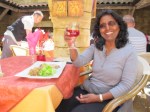


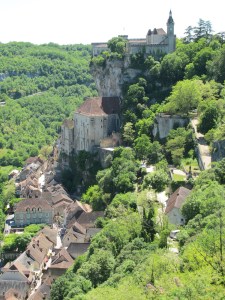













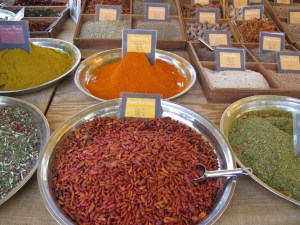
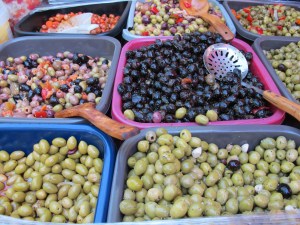

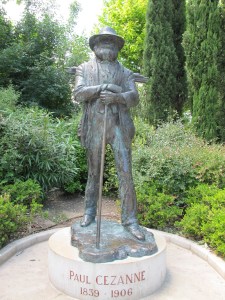
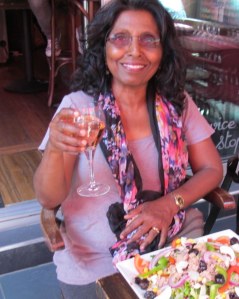
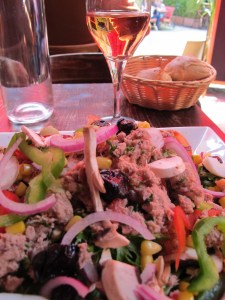


Delicious , elegant , exquisite !!SALUD !!! It is great to see you enjoying he “good life ”
Love and admire you ,
maria …Awesome .. CHEERS !!
Muchas gracias Maria. Me gusto Francia, especialmente la comida, el vino y el arte.
Good espagnol! Didn’t you adore those markets? I just love Provence…
Yeah… markets were great! Wish it was lavender season as I was looking for lavender fields…but a bit early.
What kind of camera are you using as your photographs are truly impressive? And I love the combination of cultural pieces mixed with Susheela with a glass of something. Really captures what France does best ….Food …Wine and Culture. The countryside is not too shabby either.
Thanks Carol. I used the regular Canon G11. My passion….food and culture.